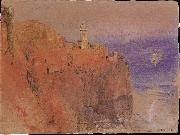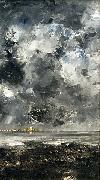
|
Joseph Mallord William Turner
|
|||
|
|
|||
| English Romantic Painter, 1775-1851 Joseph Mallord William Turner (23 April 1775 ?C 19 December 1851) was an English Romantic landscape painter, watercolourist and printmaker, whose style is said to have laid the foundation for Impressionism. Although Turner was considered a controversial figure in his day, he is now regarded as the artist who elevated landscape painting to an eminence rivalling history painting. Turner's talent was recognised early in his life. Financial independence allowed Turner to innovate freely; his mature work is characterised by a chromatic palette and broadly applied atmospheric washes of paint. According to David Piper's The Illustrated History of Art, his later pictures were called "fantastic puzzles." However, Turner was still recognised as an artistic genius: the influential English art critic John Ruskin described Turner as the artist who could most "stirringly and truthfully measure the moods of Nature." (Piper 321) Suitable vehicles for Turner's imagination were to be found in the subjects of shipwrecks, fires (such as the burning of Parliament in 1834, an event which Turner rushed to witness first-hand, and which he transcribed in a series of watercolour sketches), natural catastrophes, and natural phenomena such as sunlight, storm, rain, and fog. He was fascinated by the violent power of the sea, as seen in Dawn after the Wreck (1840) and The Slave Ship (1840). Turner placed human beings in many of his paintings to indicate his affection for humanity on the one hand (note the frequent scenes of people drinking and merry-making or working in the foreground), but its vulnerability and vulgarity amid the 'sublime' nature of the world on the other hand. 'Sublime' here means awe-inspiring, savage grandeur, a natural world unmastered by man, evidence of the power of God - a theme that artists and poets were exploring in this period. The significance of light was to Turner the emanation of God's spirit and this was why he refined the subject matter of his later paintings by leaving out solid objects and detail, concentrating on the play of light on water, the radiance of skies and fires. Although these late paintings appear to be 'impressionistic' and therefore a forerunner of the French school, Turner was striving for expression of spirituality in the world, rather than responding primarily to optical phenomena. Rain, Steam and Speed - The Great Western Railway painted (1844).His early works, such as Tintern Abbey (1795), stayed true to the traditions of English landscape. However, in Hannibal Crossing the Alps (1812), an emphasis on the destructive power of nature had already come into play. His distinctive style of painting, in which he used watercolour technique with oil paints, created lightness, fluency, and ephemeral atmospheric effects. (Piper 321) One popular story about Turner, though it likely has little basis in reality, states that he even had himself "tied to the mast of a ship in order to experience the drama" of the elements during a storm at sea. In his later years he used oils ever more transparently, and turned to an evocation of almost pure light by use of shimmering colour. A prime example of his mature style can be seen in Rain, Steam and Speed - The Great Western Railway, where the objects are barely recognizable. The intensity of hue and interest in evanescent light not only placed Turner's work in the vanguard of English painting, but later exerted an influence upon art in France, as well; the Impressionists, particularly Claude Monet, carefully studied his techniques. | |||
|
|
|||
|
The town new20/Joseph Mallord William Turner-224987.jpg Painting ID:: 54918 |
mk238 1828 Watercolour 14x18.6cm | ||
|
|
|||
|
August Strindberg
|
|||
|
|
|||
| 1849-1912 Swedish painter, sculptor and playwright. He had no art training, but learnt from artist friends after abandoning his studies at the University of Uppsala in 1872. The chief influence on him was Per Ekström, whose broken colour-spot technique he attempted to copy during his initial painting period in 1872-4 in Stockholm and on the skerry-islands Kymmendö and Sandhamn. Very little of Strindberg's early painting survives, but he had already found his special motifs: the sea, usually with turbulent waves; solitary trees or flowers on bare cliffs or sandy beaches in the outermost fringe of the skerries. After he stopped painting in 1874 he became Sweden's leading art critic, as well as the ideological leader of the radical Swedish artists' movement, which in 1884 formed the Konstnärsförbund (the Artists' Association) in protest against the Academy of Art. Prominent among the members were the painters Carl Olof Larsson, Karl Nordström and Richard Bergh. During this period, however, he produced sketches in words and pictures as illustrations to his own writings, which Carl Larsson was commissioned to do thereafter. From 1883 he stayed abroad, primarily in France and Switzerland, and belonged during a couple of long periods to the Scandinavian artists' colony in Grez-sur-Loing, near Fontainebleau in France. In 1886 in Switzerland he started photography and took a series of self-portraits that were intended for publication | |||
|
|
|||
|
The Town new25/August Strindberg-986637.jpg Painting ID:: 90696 |
1903(1903) Medium oil on canvas Dimensions 94.5 x 53 cm (37.2 x 20.9 in) cyf | ||
|
|
|||
|
Also Buy::. For Following Paintings / Artists / Products, Please Use Our Search Online: |









